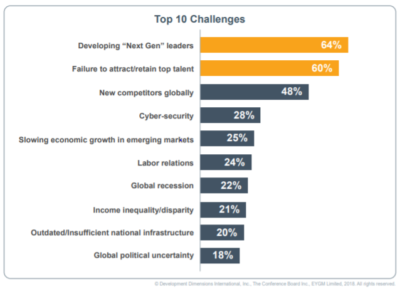5 Trends in Leadership Development
By Ellie Eckhoff, Senior Vice President
1. Inspire Leaders at Every Level
The market for leadership development solutions is enormous: more than $14 billion is spent by corporations and there are more than 70,000 books and videos on the topic. When we ask companies about their top talent issues, “improving our pipeline of leadership” always comes out near the top. (As of the last year only 14% of companies have a strong bench of leaders, two-thirds believe a new leadership model is needed, 64% also believe their top challenge is developing “next generation” leaders.
Trust lies at the heart of effective relationships. Trust generates feelings of goodwill, enables successful collaboration and more productive outcomes. Trust is based on reciprocity – you need to give it to get it.
According to DDI World, the top two challenges facing companies are developing “next gen” leaders and failure to attract/retain top talent.

https://www.ddiworld.com/resources/library/trend-research/global-leadership-forecast-2018
2. Advance Diversity Overall – Look at Gender & Generational Diversity
For generational diversity, we found that aggressive-growth organizations, such as those in the high-tech industry, have a significantly higher proportion of Millennials in leadership positions (30 percent) than organizations with cautious growth (25 percent) or no to low growth (21 percent). This 30 percent figure is linked to stronger business benefits: Companies with Millennials making up more than 30 percent of their leadership ranks are 1.8 times more likely to have high-caliber leaders in place and are 2.3 times more likely to be in the top 20 percent of financial performers.
As strong as these links are between generational diversity and company-level outcomes for leadership and growth, the effects of gender diversity are even more consequential. While there’s no magic number for gender diversity, our research shows that the benefits escalate beyond the point at which 30 percent of leadership positions are filled by women. Companies exceeding this threshold are 2.5 times more likely to have high-caliber leaders in place and a staggering 12 times more likely to be in the top 20 percent of financial performers.
The top three work preferences are the same across most age groups: development opportunities, career advancement and flexibility at work.
Recognition for quality work, manager support and opportunities to share feedback with decision-makers are the top values endorsed by all age groups at a proportion of 67% or more.
Values did not widely differ among the generations in this survey with regard to corporate social responsibility, narcissistic tendencies and short-term tenure.
“Look for three things in a person: intelligence, energy, and integrity. If they don’t have the last one, don’t even bother.” –Warren Buffet
3. Anticipate & Embrace Change
The tyranny of the urgent is what happens when leaders spend their days putting out small fires. They take care of what’s dancing around in front of their faces and lose focus of what’s truly important—their people. Your integrity as a leader hinges upon your ability to avoid distractions that prevent you from putting your people first
4. Build Coaching Culture & Skills
Active and Visible Executive Sponsorship – This is a must have. HR can only drive so much and any organizational change needs executives to support the initiative, model what good looks like, and communicate the “why” behind the what.
Goals – Both organizational and individual goals are defined, communicated, measured and reported on across the organization. Macro accomplishment for one organization was continuing to be ranked as one of the “Best Places to Work.” “We look at qualitative and quantitative measures. Is the coaching session happening or not? Were the sessions helpful and actionable? This same organization shared that 53% of employees said spending time with their supervisor is helpful, actionable and geared toward their development.”
Tools – The GROW Coaching Model is used by one organization to define individual goals, actions and accountabilities. The Predictive Index is a platform used to set up an objective coaching dialogue, because they find it helps employees understand the bias they bring to relationships.
Training – “Taking away evaluations was both a relief and worry for managers. Role playing helps them practice the skills of listening, asking powerful questions, and providing feedback. Sample scripts were developed for managers to use. Millennials love feedback and more easily grasped the non-rating performance system.”
Technology – Connect people and telling the story between the manager and employee is important. Videos and podcasts are used to share what good coaching looks like helps me learn and change. “Our CEO was captured in a coaching moment and sharing that interaction was powerful.” Also, prepare people with skills to solve problems that machines cannot. Ask, “How are they going to find new problems to solve, since machines are going to solve many repetitive challenges?”
Dedicated Budget – Having funds to support behavior change makes it real, with expectations that it will be tracked and reported, like other investments.
5. Relentlessly Drive for Results
Scott Young, who gained fame for teaching himself the four-year MIT computer science curriculum in just 12 months, says that the type of fast, focused learning he employed is possible for all of us — whether we want to master coding, become fluent in a foreign language, or excel at public speaking. And, in a dynamic, fast-paced business environment that leaves so many of us strapped for time and struggling to keep up, he believes that the ability to quickly develop new knowledge and skills will be a tremendous asset. After researching best practices and experimenting on his own, he has developed a set of principles that any of us can follow to become “ultra learners.” Young is the author of the book “Ultra learning: Master Hard Skills, Outsmart the Competition, and Accelerate Your Career.”
Remember, in age of machines, people matter more than ever.